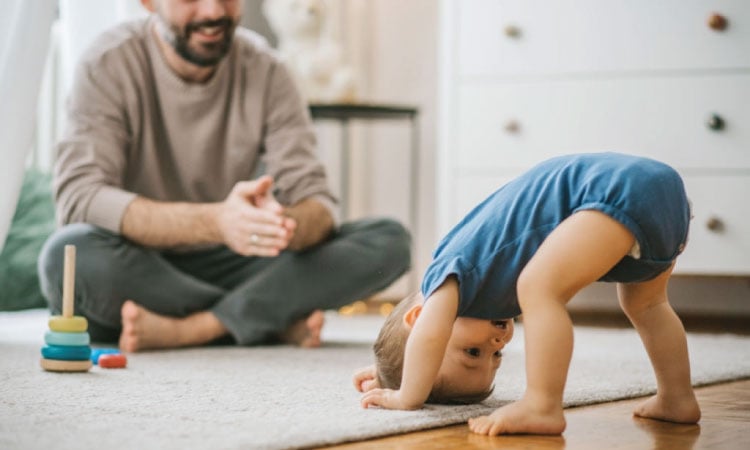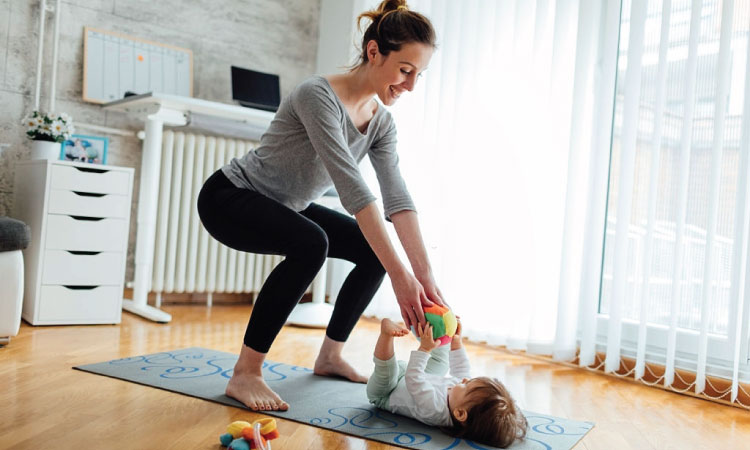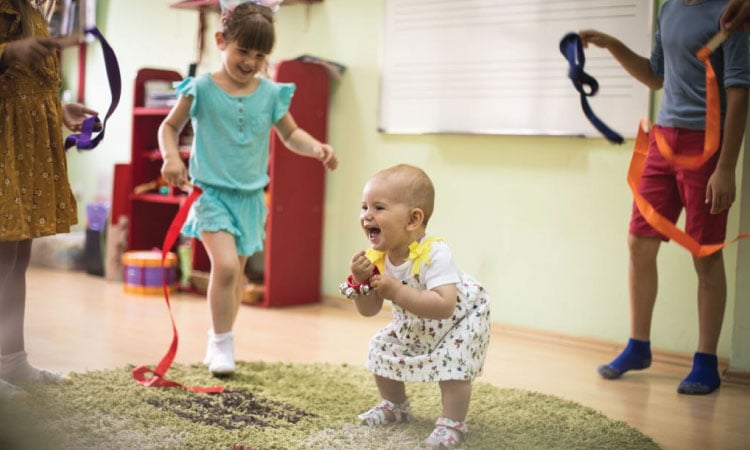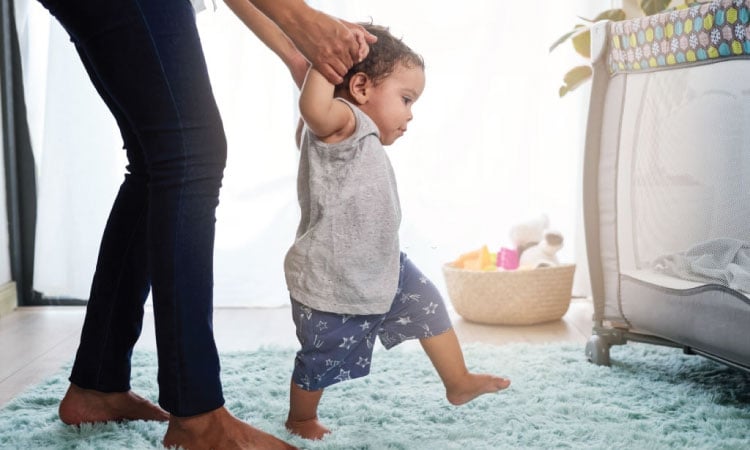For every parent, a baby’s first step means the world. The moment your baby walks for the first time, your heart bursts with joy, delight, and happiness. Most parents capture this precious moment as a memory they can relish in the future. They also start to figure out ways to encourage a baby to walk.
The way a baby walks in an unsafe fashion, trying to discover further what it feels like to stand on his feet, is a heartwarming sight. And the moment they leave the support and tries to come running to you with a grin on their face, everything seems to disappear around you, and your baby becomes your center of the universe.
Perhaps this is why every parent coaxes their babies to walk when they see those cute little bundles of joy trying to stand up. However, sticking to only one way to encourage your baby to walk isn’t productive. Babies tend to catch on to every behavior of yours easily. They will respond to one of your antics for a few days, trying to stand up and take the first step. But, if somehow he fails every time, his little mind will be discouraged. And because of this, he might not respond or show eagerness.

It is for this reason you need to assort to different tactics of encouraging your baby to walk. In this article, we have talked about other ways to encourage a baby to walk and take his first step.
10 Ways To Encourage Your Baby To Walk – Little Steps Everyday!
Encouraging the babies to walk is not an easy task. You need to understand whether they will be able to stand on their feet without falling and hurting themselves in the process. As a parent, you should always consider safety and ensure to make your baby walk in a safe place. Childproofing is an absolute must in this stage.
Since you might get confused with different tactics of making your baby walks, here, we have discussed ten ways with which you will be able to encourage your baby to walk easily.
1. Start teaching early
Usually, around 7 to 9 months of age, babies start standing on their own. You will often find them grabbing support and trying to stand upright. Sometimes, during their early period, babies keep bouncing on their knees, trying to stand erect.
Related Reading: 8 Signs Your Baby Will Walk Soon!
Once you notice such symptoms in your baby, you will have to start teaching them how to stand without falling. Starting early will help you to make your baby’s muscles and limbs healthy. Apart from this, with proper support, they will be able to manage themselves on their feet, without their knees buckling underneath.
2. Leave them barefoot in the house

According to pediatricians, it is beneficial to keep your baby barefoot for most of the time in your home. Babies always act on their feelings. Being barefoot will help them to feel the surface underneath. This will trigger a memory in their brain, and accordingly, their brains will function to prepare their bodies for standing on a particular character.
Skin contact will help them to stand and balance themselves as per the surface requirement. It would help if you allowed them to feel the floors and prepare themselves to take the first steps.
Related Reading: 18 Baby Accessories That Can Be Unsafe
3. Use walkers to train them
If your baby has learned how to stand correctly without tripping, you can use the walkers to encourage the baby to walk. Kids walkers are ladder-like supports with a broad base to support your baby’s weight. This accessory comes in various colors and shapes that will instantly make your baby happy. Walkers help steady their legs during their early age.
4. Encourage your baby to walk by providing support
Since babies have the most delicate bodies, you need to ensure that they have proper support while walking. You can either lend them your hand as a sign of encouragement to take the steps without fearing anything.
Another way to support them is by holding both their hands and making them step on your feet when they attempt walking. Their little feet in yours and you tip
Priceless moments, I tell you.
5. Encourage squat activities

Walking comes later in a baby’s life. First, he needs to learn how to stand, sit and crawl appropriately without losing balance and falling. For this reason, you need to encourage your baby to practice squats.
This is one of the best exercises which will strengthen their knees, calf muscles, hips, and thighs, allowing them to walk without trembling legs. According to several doctors, it is one of the best ways to encourage your baby to walk independently.
6. Place toys in a higher-up, reachable position
Another significant way to encourage the baby to walk is by placing the toys on chairs or tabletops where your baby can easily reach but only after standing on their feet. Since your baby values his toys the most, keeping those things in a higher place will compel him to grab them.
Try this to make your baby try walking – there will be some wailing, but when they actually do it, they will be filled with a newfound zeal for getting the toys.
7. Make the child of the room safe
When it comes to babies trying to stand and walk, every parent must consider the possibilities of accidents. For example, a chair can trip easily when your baby tries to stand by supporting the furniture. This might lead to an injury; mostly, the fall is hard.
The floors might be rough, a light mattress or a durrie will help. Ensure that there are no small toys on the floor that may hurt the baby or cause a fall. Also ensure the corners of your tables are childproofed – your child is going to use every single piece of furniture for support. So, you need to ensure that the rooms are child safe, with no such object in close vicinity that might harm your baby.
Related Reading: 18 Baby Proofing Ideas To Ensure There Are No Accidents
8. Add music to your training

Babies always get excited when they hear music or watch their favorite cartoons. If you want to encourage the baby to walk positively, you can add music to the training. Play beating music and let your kid absorb the sounds. You will soon find them throwing hands here and there or trying to sway their body in the rhythm of the music.
There! You have a dancer. The more your child wants to move his hands and feet, the earlier he will learn balancing himself on his two feet. Well, the early signs of intelligence are right before your eyes.
9. Coax them to explore
These little munchkins are very curious. And you can use their curiosity and eagerness to encourage them to walk. If your baby is trying to crawl out of the room and venture into the hallway or tries to stand by using the kitchen counter as the support, do not stop them from doing so. Just keep an eye out so that they don’t end up hurting themselves.
10. Allow your kids to play with others.

Lastly, it would help if you allowed your kid to play with others, too, at times. Kids learn the most with other kids – whether its walking, eating, talking or anything else. When your baby other kids standing or trying to walk, your kid will try to imitate them. This will encourage them to stand on their own apart form helping their social skills.
Nothing can quite match this – babies are great imitators and it would be the best way to teach them to walk. Let them fall, trip, laugh and play with other kids often- this is the best exposure.
What delays a baby from walking?
Usually, babies learn to stand around ten months of age and walk around twelve months of age. This is the average age where most babies start showing walking symptoms and even try to take the steps without your help.
However, in some cases, babies are late bloomers. Hence, they might not start walking around the predicted time. If your baby is also showing delay in walking, there is nothing to worry about. Following are some of the reasons that delay your baby from walking.
- Sometimes, delay in walking can occur due to the late maturation of the motor skills in babies
- If your baby’s cognitive development is slow, it’s quite natural that they will show signs of the standing of walking later on
- In some instances, muscle tuning abnormalities can make your kid a late bloomer in standing and walking
How late can babies start walking?
If your baby is a late walker, you have nothing to worry about. Due to improper muscular coordination or late motor maturity, sometimes babies can start late by a month or two. But, usually, even the late bloomers can stand perfectly and walk small steps by the end of the seventeenth month.
Based on their physical and cognitive development pace, you will assess the time around which they will start showing signs of standing and walking. Once you notice them, please start with the tips we have discussed above. You might have to double your efforts to encourage your baby to walk if he is a late bloomer.
Is walking early or late related to intelligence?

When it comes to the waking time of your baby, time becomes essential. Both the standing and walking activities depend on the development of their mind and motor skills. So, yes, an early walking baby might show faster cognitive development signs than a late walking baby.
However, this one incident shouldn’t be the judging factor of how intelligent your kid is. Doctors and pediatricians consider a lot of other evidence to decide how smart a baby is.
An early walking baby is just curious and super excited to get on his feet and explore. Similarly, a late walker might be too reluctant to stand up or might not have the needed motor strength in their body.
Conclusion
Many parents have always expressed their concerns about how can I help my baby learn to walk. For them and all other new parents, we have explained the top tactics that will most certainly encourage your kid to take the steps slowly but surely. So, get ready to witness one of the special moments in your and your baby’s life as he will take his first step with a grinning laugh and elated body language.
